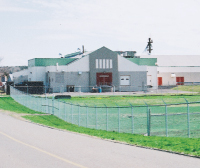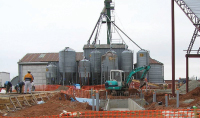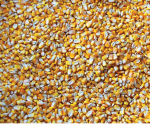
A new feed manufacturing facility will allow researchers more flexibility and meet regulatory guidelines
 |
| QUALITY CONTROL The Atlantic Poultry Research Centre (above) will house a modern feed mill for the NSAC, replacing the existing outdated facility (below). |
 |
By mid-August, the second phase of the Atlantic Poultry Research Centre at the Nova Scotia Agricultural College should be completed.
Lana Crewe, NSAC’s poultry, fur and feed mill co-ordinator, hopes the new feed mill facilities will be tested and operating by September when students arrive for classes at the research centre.
The APRC has a dual role, she emphasized, of both research and instruction.
The new mill building replaces obsolete feed preparation facilities at the NSAC that were built in the mid-1960s. The mill and its equipment will cost between $1.3 and $1.5-million.
Around the 128 x 60 foot mill structure, Crewe said, there will be 10 bulk ingredient tanks of varying dimensions: four large tanks, two medium-sized vessels and four small tanks. The four large tanks, each of 2,000 cubic feet capacity, will hold wheat, corn, barley and possibly alternative ingredients.
The two medium-sized tanks, each of 1,150-cubic-foot capacity, will likely contain canola and soybean meal, while the four smallest 300-cubic-foot capacity tanks will possibly hold ingredients such as distillers’ grain and alfalfa.
Crewe added: “We purchase our ingredients, as much as possible, through local mills in town (Truro). Also, we buy from our suppliers special nutrients, vitamins and minerals used in our micro-mixes.”
Regulatory changes have also dictated the need for new feed preparation facilities, she observed. “As things change in animal husbandry, quality control is required to meet the food safety requirements imposed on producers. So, our standards of feed preparation must be improved.”
She continued: “We have never had a pelletizing and small batch mixing facility. Now, students can come in and mix their own diets within a well-laid-out room with the appropriate equipment.”
Inside the feed facility, Crewe said the ingredient flow will follow best management practices, with ingredients arriving at one end of the building, then moving to the mill for processing and leaving at the other end as finished feed, which was not possible at the old mill building. “We will have computer software that will be able to track the product from the time it comes in until it leaves.”
 |
| The new facility will have computer software that will be able to track product from the time it comes in until it leaves. |
The new facility will have a vertical mixer with a Windows-based computer for a batch control system, with a real-time automated display both at the mixer and in remote stations. “So, if I was at home; I could connect to it and see what was going on,” she said, adding, “ It will be able to give us the reports we need and the traceability that is required.”
Crewe noted: “The goal is to have the mill follow the good management practices and ultimately become HACCP-certified.”
She said the APRC mill is modelled “after one we saw at the University of Manitoba.”
The APRC feed facility will also have a two pair, high roller/grinder mill, Crewe said. “It will increase our capability of what we process and produce.
As planned, the feed facility will provide diets for poultry as well as the NSAC’s cattle and sheep, plus, potentially in the future, for its aquaculture and fur animal research.
The mill will also have exterior load-up tanks for processed feed for loading on trucks that will then transport it to the APRC and the nearby Ruminant Animal Centre or wherever NSAC is doing animal research. “This is a huge difference for us because previously we had filled the trucks inside the mill building,” she said.
“We are using portable poly bins for small diets. They will be on pallets which a forklift will then take to the poultry feed room which can hold 16 of these bins, 12 for broilers and four for layers,” Crewe said.
“This way we will have no more open bag products. Everything will be in a sealed bin and we will eliminate the use of totes for our feed.”
The new feed mill building will be designated as The Chute Animal Nutrition Centre, in recognition of Dr. Harold Chute and his family, who donated almost $200,000 towards the construction cost of the feed facility.
Dr. Chute graduated in the NSAC degree program in 1944, going on then to further study at the Ontario Veterinary College, Ohio State University and the University of Toronto.
He had a distinguished career at the University of Maine as a poultry pathologist during which time he developed several strains of vaccine to combat Newcastle Disease.
The Chute Centre can mix small and large batches, do precision premixing, grind and roll ingredients, extrude ingredients, pelletize small and large batches and do ingredient inventory control. Its feed preparation will support animal science, said Crewe.
Following the official opening of the first phase of the $9.8-million APRC in May, 2007, two full cycles of broilers and a teaching flock have gone through the broiler research unit since last September. Crewe said the initial flock of layers which arrived last August are still in the egg research unit; and the next group of broilers arrived in the latter part of May, “when the next research cycle got underway.”
At the APRC itself, the controlled environment rooms are in the final design stage, with tentative plans calling for the building of two prototype rooms, “to work out the bugs,” she said, before building the rest of the controlled environment suite.
Print this page